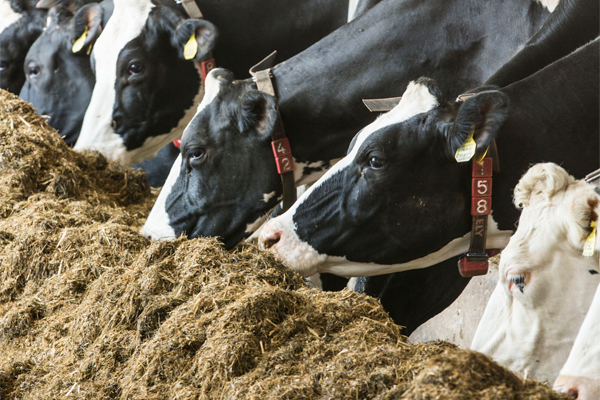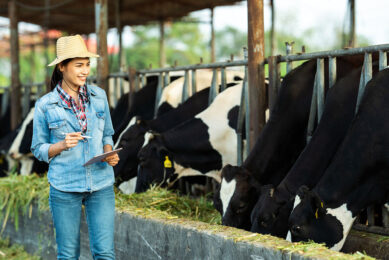Dietary nitrate for cows reduces methane

Cows produce less methane when they are fed nitrate-amended feed. Now results show that this can result in emissions of nitrous oxide (N2O).
Addition of nitrate to feed for ruminants such as cows and sheep is a new and promising method to reduce emissions of the greenhouse gas methane. Feeding trials in several places, including Aarhus University, have shown that a significant reduction can be achieved with no negative effects on milk yield or health.
However, it now turns out there is a snag with the method: feeding dietary nitrate may also lead to emissions of nitrous oxide (N2O, laughing gas). This is the conclusion of experiments at Aarhus University where for the first time it has been documented that nitrous oxide is emitted directly from cows receiving dietary nitrate.
Just like methane, nitrous oxide is a greenhouse gas and therefore must be included in the balance to determine benefits of dietary nitrate for the climate. The experiments at Aarhus University showed that, when taking emissions of nitrous oxide into account, the benefit of feeding dietary nitrate was reduced by 10-20 percent.
Source of nitrous oxide
The first observations were made with a laser instrument and showed a high, but very variable emission of nitrous oxide at higher levels of nitrate in the feed. There was a very close link between feed intake and nitrous oxide emissions which indicated that nitrous oxide came from the animals themselves.
The link between dietary nitrate and nitrous oxide emissions from cows was confirmed in two additional feeding periods with other combinations of animals and feed mixtures. Also a number of other measurements were carried out which demonstrated that neither feed nor excreta (dung and urine) could be the source of nitrous oxide.
The cows that were used in the experiments were rumen-fistulated, that is, they had a hole with a plug to the rumen for direct access to sampling of rumen content. The scientists found in a separate control experiment that rumen fistulation was also not a possible source of the observed nitrous oxide emissions.
Nitrous oxide emissions – mechanisms not known
“It is the first time that nitrous oxide emissions directly from cows fed dietary nitrate has been documented, but we still do not know the exact mechanism behind its formation,” says senior scientist Søren O. Petersen from the Department of Agroecology at Aarhus University.
Concentration of nitrite in the rumen were measured at several time points around feeding, but did not indicate a link to the emission of nitrous oxide. Instead it is proposed that nitrous oxide is produced in the oral cavity via bacterial denitrification.
“More studies are needed to understand mechanisms and evaluate long-term effects of this strategy to reduce greenhouse gas emissions,” says Petersen.
The experiment was a collaboration between the Departments of Agroecology and Animal Science at Aarhus University.
The results have been published in the article “Dietary nitrate for methane mitigation leads to nitrous oxide emissions from dairy cows” in Journal of Environmental Quality. The article is available here.
For further information: Senior Scientist Søren O. Petersen, Department of Agroecology, telephone +45 8715 7756, email: soren.o.petersen@agro.au.dk
Senior Scientist Peter Lund, Department of Animal Science, telephone +45 8715 8072, email: peter.lund@anis.au.dk
Source: Aarhus University











